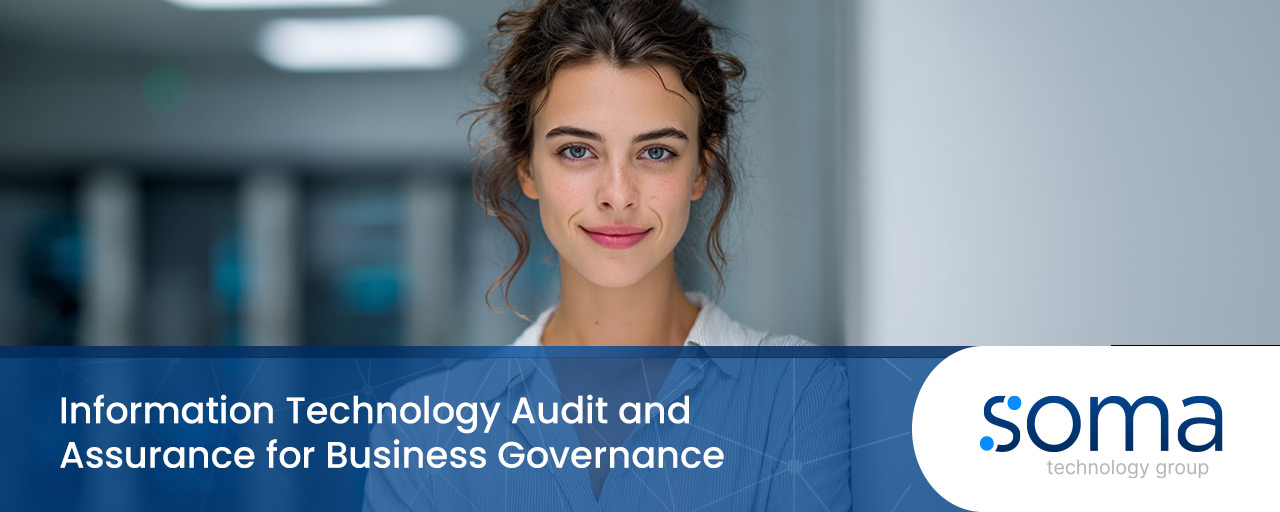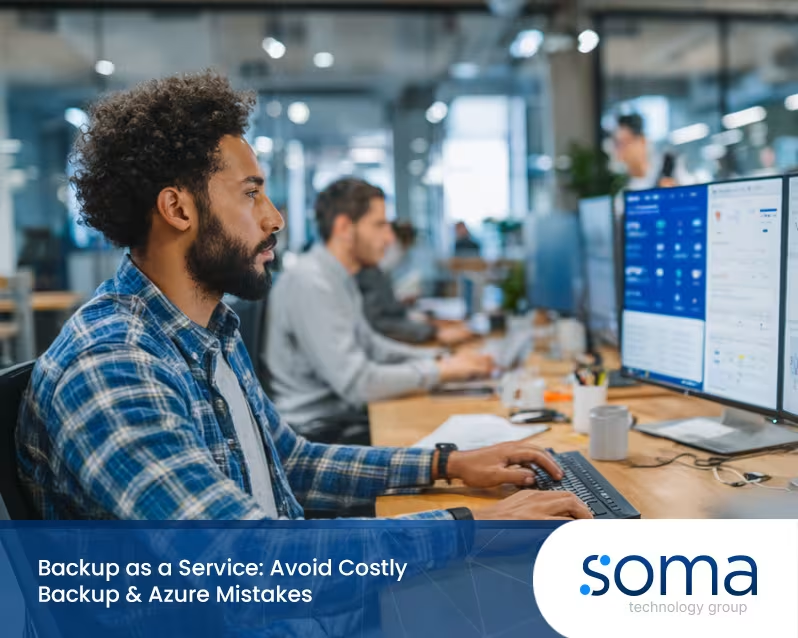
Information Technology Audit and Assurance for Business Governance
If your organisation has between 20 and 1000 staff using laptops, desktops, or mobile devices, a professional IT audit is essential. It ensures your systems are secure, compliant, and aligned with business goals. This guide explains what an IT audit involves, why it matters, and how to prepare effectively.
Whether you're scaling operations or maintaining compliance in a regulated industry, understanding IT audit and assurance processes will help safeguard your business. We’ll also explore areas such as disaster recovery, data accuracy, and certified system controls to give you a complete picture of what's involved.

What is the IT audit process?
An IT audit is a structured evaluation of your organisation’s technology systems. Its purpose is to assess whether those systems are secure, efficient, and aligned with both regulatory standards and internal policies.
The audit process typically includes reviewing access controls, system configurations, backup procedures, incident response plans, and user policy enforcement. For organisations growing in size or complexity, regular audits help ensure your IT infrastructure scales safely while maintaining performance and compliance.
Audits may be conducted internally by your own team or externally by independent professionals. Internal audits are useful for continuous improvement and preparing for third-party assessments. For businesses managing complex environments, an IT and auditing strategy ensures long-term system resilience and risk mitigation.
Types of IT audits: What each one covers
Different types of IT audits focus on specific components of your technology environment. Understanding each type helps ensure comprehensive coverage during evaluations.
Information security
This audit focuses on how well your organisation protects sensitive information from unauthorised access. It examines encryption standards, password policies, system access levels, and data protection protocols. A focused IT security audit in this area helps identify gaps in your current defence strategy.
Technology risk
Technology risk audits identify weaknesses that could lead to service interruptions or data loss. These often include outdated software, weak configurations, or unmonitored systems.
Audit checklist
An audit checklist standardises the process across departments. It typically includes firewall settings, patch management status, antivirus coverage, access logs, and backup verification.
Governance
Governance audits evaluate how closely your IT operations align with business goals and internal policies. They also assess leadership involvement in technology planning and decision-making.
ISACA standards
ISACA provides globally recognised frameworks for auditing IT environments. Aligning with these standards ensures your audit meets best-practice benchmarks and industry expectations.
Information security audit
This is a deep-dive into how digital information is handled within your organisation. It assesses file permissions, data classification protocols, secure transmission practices, and storage safeguards. A comprehensive information security audit supports both compliance and operational reliability.
Risk advisory
A risk advisory audit helps prioritise technology investments by identifying areas where failure could have the most significant business impact. It provides guidance on strengthening systems against emerging threats and enhances your ability to audit IT systems effectively.

Business benefits of an information system audit
A well-executed information system audit doesn’t just tick compliance boxes—it delivers measurable value:
- Identifies vulnerabilities before they lead to costly incidents
- Ensures compliance with laws like the Privacy Act
- Eliminates inefficiencies by uncovering redundant systems
- Increases client trust through stronger data protection
- Supports smoother due diligence during mergers or funding rounds
- Encourages consistent documentation across departments
These outcomes help businesses operate more securely while supporting long-term growth. Conducting regular IT audits also promotes accountability and transparency across departments.
Internal audits: Laying the groundwork for assurance
Internal audits are a proactive way to maintain system health throughout the year. They allow teams to spot issues early—before they affect productivity or compliance.
Ideally conducted annually or biannually, internal audits should be well-documented with clear findings and follow-up actions. Including departments such as finance or HR ensures that all operational needs are considered during the review.
Internal audits also build organisational assurance by confirming that security controls are functioning as intended across all workflows. This internal IT and auditing process lays a strong foundation for external assessments.
Critical areas every IT audit should address
An effective IT audit covers multiple areas tied directly to daily operations and regulatory requirements. Each plays a key role in protecting organisational integrity.
Auditor responsibilities
Auditors must evaluate systems objectively and provide practical recommendations. Their independence ensures that findings are accurate and not influenced by internal bias.
Compliance requirements
Compliance reviews confirm adherence to standards like ISO 27001 or industry-specific frameworks. Failing to meet these can result in penalties or reputational harm.
Certified information systems
Using verified technologies that meet established security standards improves reliability across your environment—and simplifies audit evaluations.
Cybersecurity measures
Cybersecurity audits validate that protective tools such as antivirus software, firewalls, and intrusion detection systems are up-to-date and correctly configured. This type of IT security audit is essential for defending against evolving threats.
Disaster recovery planning
This area reviews how quickly operations can resume after an outage—whether caused by cyberattacks or natural events—and whether recovery plans are tested regularly.
Data integrity controls
Data integrity checks confirm that information remains consistent across systems over time. This is especially important for reporting accuracy and compliance documentation.
Security controls testing
Security controls include user authentication methods, access restrictions, network monitoring tools, and more. Audits verify these controls are both active and effective. A thorough computer security audit ensures these layers are working as intended.

Building a strong computer security audit strategy
A successful computer security audit starts with preparation. Define clear goals based on current business risks—whether improving compliance posture or reducing downtime vulnerabilities.
Gather relevant documentation early: system diagrams, staff access lists, software inventories, past incident reports—all help auditors work efficiently. Assign a point of contact internally to assist throughout the process for smoother communication.
Most importantly, act on findings promptly. An audit reveals where improvements are needed; don’t delay fixes that could reduce risk exposure moving forward. A targeted audit IT strategy should include timelines for implementing all recommended changes.
Best practices to manage IT systems between audits
Ongoing management helps keep your systems secure year-round—not just when an audit is due:
- Keep configuration documents updated for easy reference during audits
- Review staff access rights regularly to limit unnecessary privileges
- Implement multi-factor authentication on all critical platforms
- Schedule monthly vulnerability scans to detect risks early
- Conduct security awareness training for all employees
- Test backup procedures regularly to ensure quick recovery if needed
These practices not only improve day-to-day security but also make future audits faster and more accurate. Maintaining a strong IT and auditing routine reduces long-term risk exposure.
How soma supports your IT audit journey
If you’re preparing for an upcoming audit—or want to know where your current setup stands—soma can guide you through every step of the process. Based in Gold Coast, Queensland, we’ve worked alongside auditors across various industries to help businesses strengthen their technology environments without disrupting growth plans.
Rather than just delivering a report filled with technical jargon, we walk you through each finding so you understand what needs immediate attention versus what can be addressed later on. When you're ready to take control of your IT risks while maintaining momentum—soma is ready to help with your next IT audit.

FAQs about IT audits
What does the full audit process involve for businesses with growing teams?
The full audit process begins with defining scope based on business size and operations—then moves into reviewing policies, access controls, monitoring systems, data handling procedures, and disaster recovery readiness. It concludes with detailed recommendations from the auditor outlining areas of strength and weakness.
As businesses expand their use of information technology across departments like HR or finance, internal audit procedures must evolve too. A robust assurance strategy includes regular reviews led by a qualified auditor who understands both technical infrastructure and governance requirements relevant to your industry.
How does information technology support compliance during an external review?
Information technology systems play a crucial role in demonstrating compliance during external assessments—especially when dealing with regulated sectors like finance or healthcare. Well-documented user access logs, encrypted communication channels, backup protocols, and multi-factor authentication all support strong compliance outcomes during an information technology audit.
Auditors look for evidence that these systems not only exist but are consistently applied across all users. Internal governance procedures must support this consistency by assigning roles clearly within IT teams responsible for updates and monitoring activity logs tied to critical assets.
What should be included in an effective information technology audit?
An effective information technology audit should cover infrastructure security measures such as firewall configurations; application-level controls; identity management; system update schedules; cloud service usage; vendor risk assessments; physical asset security; disaster recovery testing; and employee training records related to cybersecurity best practices.
As part of this broader assurance framework, the audit team will evaluate how each element supports ongoing stability while meeting regulatory expectations—particularly when using certified information platforms aligned with ISACA guidelines or ISO standards around data integrity protection measures.
How can I use an audit checklist effectively?
An effective audit checklist standardises how internal teams prepare for external reviews—or conduct their own assessments annually. It typically includes items like patch status reports; antivirus deployment checks; user deactivation logs; system hardening settings; encryption protocol reviews; backup verification steps; vendor contract documentation; incident response drill records; among others.
Using a checklist allows different departments (like operations or finance) to contribute relevant inputs without missing key areas of concern tied to governance policies or risk advisory goals set at board level. This ensures a complete picture of organisational readiness across all areas of an IT audit framework—not just cybersecurity concerns alone.
What’s the difference between various types of IT audits?
Each type of IT audit addresses different organisational priorities: governance audits focus on alignment with leadership strategy; cybersecurity audits assess technical defence layers; risk advisory reviews prioritise high-impact vulnerabilities; while compliance audits ensure legal obligations are met under frameworks like ISO 27001 or national privacy laws.
By engaging different types of auditors specialised in these areas—whether through external consultants or your own internal team—you gain broader assurance across both technical infrastructure and business processes that support secure service delivery at scale using certified information platforms guided by ISACA principles where appropriate.
Why should I consider financial audits alongside broader areas of an IT audit?
Financial audits often rely heavily on accurate digital records managed through enterprise resource planning (ERP) platforms—which are part of broader areas assessed during an IT audit. If those platforms lack proper access control or data validation checks audited under cybersecurity protocols—it can lead to material misstatements in financial reporting obligations later reviewed during tax filings or investor disclosures.
Integrating financial oversight into broader governance-focused assurance programs reduces duplication while improving transparency—especially when led by CISA-qualified auditors familiar with risk management frameworks that bridge both financial accuracy concerns and wider disaster recovery planning efforts critical for operational resilience.
.svg)
.webp)


